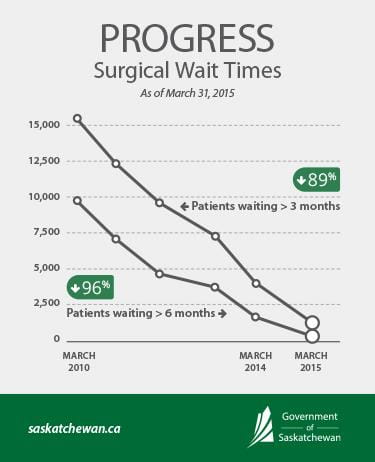Released on May 26, 2015
One Year After the Surgical Initiative
The dramatic reductions in surgical wait times that began during the four-year Saskatchewan Surgical Initiative have continued, with even more patients receiving sooner, safer, smarter surgical care a year later.
The number of patients waiting more than three months for surgery is down 89 per cent, with 13,613 fewer patients waiting that long for surgery on March 31, 2015 than in March 2010.
“Saskatchewan patients now have much better access to surgery,” Health Minister Dustin Duncan said. “The combined efforts of thousands of health system staff and physicians have transformed the surgical care experience so patients spend less time waiting and are able to recover sooner.”
Of the 10 health regions that offer surgery, seven had zero patients waiting longer than three months for surgery as of March 31, 2015.

Showing big improvement in the past year, Regina Qu’Appelle Health Region reduced the number of its patients waiting more than three months to 443 (down from 2,314 a year ago). Prince Albert Parkland Health Region had just 20. Saskatoon Health Region experienced a surge in demand for surgeries during 2014-15, but was still able to reduce its number of patients waiting more than three months to 1,215 (down slightly from 1,469 in March 2014, but an 84 per cent reduction from the more than 7,719 patients waiting that long in 2010). Saskatoon provided 39,348 surgeries in 2014-15, nearly 2,000 more than the previous year and close to half of the 89,420 surgeries provided by Saskatchewan’s health system.
For the period January 1 to March 31, 2015, 89.2 per cent of Saskatchewan surgical patients received surgery or an offer of surgery within three months, up from 80.8 per cent during the same period a year ago.
Many improvement projects that began under the Surgical Initiative are continuing:
- An online Specialist Directory helps patients identify surgical options;
- The number of specialist groups that pool referrals continues to grow, allowing patients the option to see the first appropriate specialist, or wait for a specific specialist;
- Timely and appropriate care through clinical pathways continues, with work underway on acute stroke care and lower-extremity wounds;
- A focus on reducing the use of MRIs for lower back pain except when symptoms indicate that an MRI exam is appropriate; and
- Expanded capacity through third-party surgical and diagnostic services.
Monthly wait time updates for each health region are posted on
www.sasksurgery.ca.
-30-
For more information, contact:
Tyler McMurchy
Health
Regina
Phone: 306-787-4083
Email:
tyler.mcmurchy@health.gov.sk.ca
Cell: 306-537-3594

